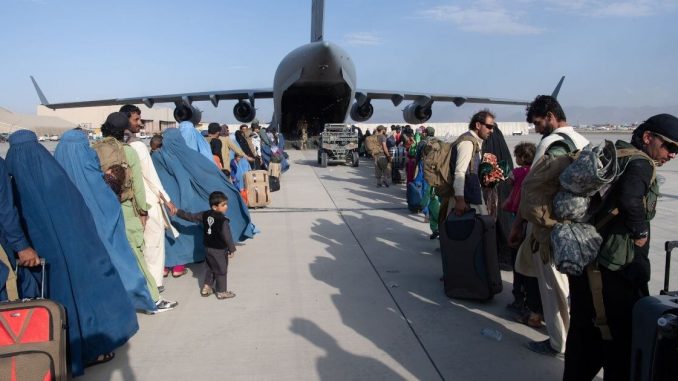
Hope and pray we never reap the consequences of just how bad the vetting during the evacuation of Afghanistan was.
We’ve heard allegations that men brought child “brides” they had sexually assaulted along with them in the airlift. On Tuesday, reports emerged that one contractor was able to get explosive materials onto a flight out of Kabul, although it was discovered before he flew from Germany to the United States.
And while these could be brushed off as scattered incidents if the evacuation had gone well otherwise, it turns out most of those we got out of the country weren’t the “Afghan allies” we intended to evacuate.
Bloomberg reported last week that of the roughly 124,000 people we got out, “a small percentage of the Afghan citizens who got out are the ones the U.S. pledged to place at the top of its priority list” and “many got out because they were part of the initial crush of people who made it to Kabul’s airport as the city fell to the Taliban or secured passage through airport gates thanks to luck or help from people in the U.S. or elsewhere.”
And now, it turns out we’ve identified dozens who are national security threats.
According to a report in Friday’s Washington Post, the Department of Homeland Security has flagged 44 individuals who were evacuated in the airlift during two weeks of screening.
“Of the more than 60,000 evacuees who have arrived on U.S. soil since Aug. 17, the lists show, 13 Afghans remain in U.S. Customs and Border Protection custody awaiting additional screening and review procedures, including interviews with FBI and counterterrorism teams,” the Post’s Nick Miroff reported.
“Another 15 evacuees who were considered security concerns have been turned over to U.S. Immigration and Customs Enforcement (ICE), sent back to transit sites in Europe or the Middle East, or in some cases approved for release after additional review. There are 16 Afghans on the DHS lists who have not been cleared to travel and remain overseas at the transit sites U.S. officials call ‘lily pads.’”
These are the ones we’ve been able to identify, of course. Do we know how many exist among the 95,000 Afghans President Joe Biden’s administration has announced it intends to resettle here?
The administration says yes: “Biden officials say the vetting is rigorous and multifaceted, drawing on military, intelligence, law enforcement, and counterterrorism agencies and their databases,” Miroff reported. “Evacuees who aren’t approved will not be released into the United States.”
“The Biden administration has not said what Afghan records and databases it may have access to, but observers say the United States has gathered a significant amount of intelligence information during a 20-year military presence,” he added.
If Miroff believes that, he has a short memory.
On Sunday, the Post published a piece in which Miroff was one of three writers to receive bylines. In it, the capital’s paper of record reported the experience of Mustafa, one of those “Afghan allies” we tried our hardest to airlift out of the country.
After boarding an American military plane, Mustafa “glanced around at the other weary Afghans and was struck by what he saw.”
“Many had minimal identification and did not appear to have worked closely with the United States as he had, serving as a translator and analyst. They were ‘just people,’ he said, who took advantage of a disorderly evacuation to flee their turbulent country.”
“Nobody knows who was the good guy and who was the bad guy getting into the plane,” Mustafa said. “It’s a risky thing that I believe happened.”
When asked by the Post how many of the evacuees were among those “Afghan allies” who worked with the United States and were therefore in danger of Taliban reprisal, Department of Homeland Security Secretary Alejandro Mayorkas said, “I can’t really quantify it or measure it against expectations.”
As for screening the 95,000 evacuees they plan to bring to the United States, the administration has been similarly vague, with Secretary of State Antony Blinken saying that they were “doing accountings on the back end as people arrive in the United States.”
“In our effort to get as many people out as fast as we can while we had the airport functioning, we focused on doing just that,” Blinken said during a news conference in Qatar this week, according to Fox News.
U.S. House Republicans are dubious about the administration’s back-end-accounting capabilities, however, drawing attention to the “rushed and incomplete vetting” in a letter to Biden on Wednesday.
“Various officials of this administration have stated that Afghans will receive serious vetting and biometric and biographic security screenings from law enforcement and intelligence officials in the United States,” the lawmakers wrote in the letter.
“While we do not dispute that some level of screening is occurring, screening is only as good and comprehensive as the information within the databases that are checked.”
And we don’t know what databases those are — or what information we can check those refugees against if they don’t have proper identification.
We’ve already discovered 44 people who were allegedly threats to the United States that wanted to come here. We’re supposed to believe there aren’t more that couldn’t be identified, particularly with the lack of vetting they underwent and paucity of identification many of them had?
There’s no amount of “accountings on the back end” that could make that believable — which is why we have every reason to believe Biden’s big mistake could get even worse, no matter how much we hope or pray.
Via The Western Journal.
